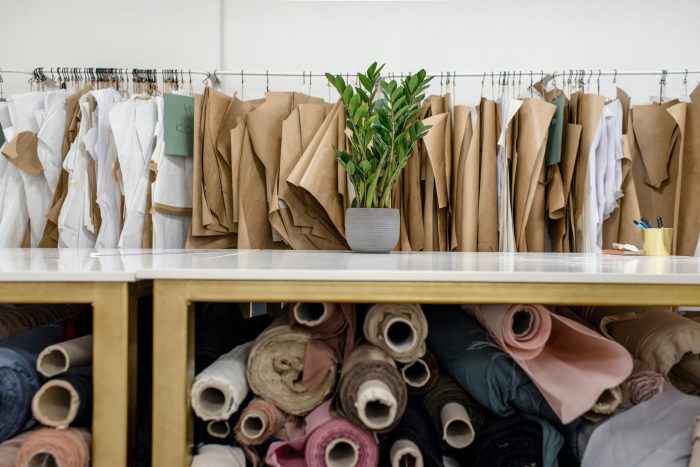Are you looking to start wearing more plant-based fabrics? Do want to find out more reasons why plant-based fabrics are healthy to wear? Would you like to learn several new and current plant-based fabrics on the market and plant-based fabrics you may never have heard of? If so, then this article is for you.
Plant-based cellulosic and bio-based fabrics are the future of fashion. Ergonomic plant fabrics are made from plants like cotton, hemp, linen, and bamboo. They are luxurious because they are soft and comfortable to wear. Plant-based fashion is a new luxury. Plant-based apparel is a part of a healthy lifestyle. It is luxurious to be healthy.
Many of the current alternative, natural, and herbal remedies are relevant to the times. We all want to practice a holistic lifestyle. So, having a medicinal perspective on plant-based fashion is important, and critical. All industries want to develop healthier products. For example, tableware suppliers and manufacturers are producing bio-based plates, cups, and napkins, instead of petroleum-based tableware.
The issue with synthetic fabric like polyester
The fashion industry is the 2nd most polluting industry in the world. The 1st most polluting industry is the petroleum oil industry. The fashion industry is the second most polluting industry because the textile industry is producing fabrics made with petroleum oil. If we stop using petroleum oil to make fabrics, there will be less pollution.
Synthetic fabrics are not the future of fashion because they are made from crude oil, a non-renewable resource, and are non-biodegradable. Plant-based fabrics are buried, burned, and composted without harming the environment. They create no harm to a person or the environment. I have personally smelled burning plastic, and it always gives me a headache and makes me feel sick.
Plant-based fabrics will also be a solution for the micro-plastic pollution issue. They may also be able to promote health and lessen sickness and disease. Fashion consumers may be getting a little poisoned by the chemicals found in these synthetic fabrics, dyes, and fabric treatments.
There is a global overuse of synthetic petroleum oil-based apparel. Textile manufacturers like Monsanto and Dupont have produced synthetic fabrics. These two companies have been two of the largest initial creators and producers of synthetic fabric since the ‘30s.
Synthetic fabric is not supporting the body completely. I wear synthetic fabrics like polyester coats and shoes, but most of my wardrobe is not synthetic-based. However, it is challenging to find 100% plant-based apparel for cold weather, so a few of my sweatshirts and other garments are made with polyester/cotton blended fabrics. Additionally, I wear a small amount of lycra in my leggings.
I mostly wear all cotton and a little linen. The texture, hand-feel, and breathability of the plant-based fabric are important to me. So, when I choose a synthetic-based garment or accessory I make sure it has an ergonomic texture and comfortable feel to the fabric.
Plant-based fabrics are medicinal + good for our mind, body, and spirit:
Plant-based fabrics are authentic. Fabrics made with natural plant-based fibers are biodegradable. Low-impact dyestuffs that are not made with 100% vegetable or plant-based dyes are also good to wear. Low-impact dyestuffs are made with less toxic chemicals that are gentle to the body.
Many synthetic fabrics are made with chemicals and ingredients that are carcinogenic. Plants help our body because they allow the skin to breathe. Unless synthetic fabrics are fit loose on the body, they do not allow the skin to breathe.
One specific textile industry method that supports human health is Ayurvastra. Indians from India created Ayurvastra. The concept of Ayurvastra is natural fabrics dyed with healing herbs and healing plants. They also use castor oil, coconut oil, and other healthy ingredients to treat the fabric.
Ayuvastra fabrics are fabrics dyed with herbs like aloe, neem, turmeric, tulsi, and holy basil. Most herbal ayurvedic dyers only dye small batches of fabric. However, Archroma is a mass textile dyer, and they have developed technology to dye large amounts of fabric with herbs.
The five plant-based fashion fabrics that are currently available, mass-produced, and are the foundation fabrics of the textile industry:
- cotton
- linen
- Tencel™
- bamboo
- hemp
Plant-based fabrics will automatically slow down the fashion industry.
One reason, why our fashion industry is not 100% plant-based is because we have not developed and manufactured other plants like ramie and nettle. Cotton and linen cannot be the only two fabrics produced for apparel, it will put too much stress on those two plants.
The current plant-based, mass-produced fabrics mostly consist of cotton, hemp, and linen. There is a range of different plant-based fabrics; we just have not manufactured them yet for the masses. The textile industry is always updating its fabric library. The textile industry and many fashion businesses have plans to introduce several more versatile, interesting, and therapeutic natural fibers.
The five small-batch produced plant-based fashion fabrics:
- nettle
- ramie
- bamboo linen
- pina
- cork
There are consistently new plant-tech fabric patents being invented like:
Bambor® is a patented fabric made with cotton, bamboo, elastane by Asquith
Vitadylan™ is a patented Tencel fabric made with wood pulp, zinc, and seaweed powder
Rose-bush fabric by Regina Polanka has created a new blended fabric with cotton and 20-40% rose-bush fiber
Several modern brands are creating plant-based alternative apparel. Instead of polyester-based activewear apparel, some brands are using an alternative like jersey knit Tencel™. Instead of polyester down for winter apparel, several brands are producing down coats made with kapok plant down.
What is interesting is there’s no specific fashion style that is produced in plant-based fabrics. All different fashion style types like glamour, relaxed, retro, athleisure, elegant, clean, classic, chic, minimal, urban can be made and produced with plant-based fabrics.
Spiritual figures, monks, swami gurus, priests, and priestesses all mostly wear cotton and linen-based apparel. There are a lot of spiritual communities that wear robes in cotton. The monks and swami gurus all wear cotton daily.
I believe part of the reason is that cotton is a plant. When we are in nature, it is spiritual. It is a place to meditate and feel comfortable. Additionally, it is known that people have designed and styled, clothing to keep a person’s life force within the person’s body.
Final Thoughts
It is essential to wear plants like cotton and linen because they help the body. Plant-based fashion fabrics will be the new most successful type of fabrics to wear in the future. More research is necessary to scientifically prove plant-based fabrics support and promote the health of the body, but it is happening, and plant-based fabrics are healthy to wear. Plant-based fabrics dyed with low-impact dyes or plant-dyed fabrics are the future of fashion.







Read 0 comments and reply